Mantas are found in warm temperate, subtropical and tropical waters. Both species are pelagic; M. birostris migrates across open oceans, singly or in groups, while M. alfredi tends to be resident and coastal. They are filter feeders and eat large quantities of zooplankton, which they swallow with their open mouths as they swim. Gestation lasts over a year and mantas give birth to live pups. Mantas may visit cleaning stations for the removal of parasites. Like whales, they breach, for unknown reasons.
Both species are listed as vulnerable by the International Union for Conservation of Nature. Anthropogenic threats include pollution, entanglement in fishing nets, and direct harvesting for their gill rakers for use in Chinese medicine. Their slow reproductive rate exacerbates these threats. They are protected in international waters by the Convention on Migratory Species of Wild Animals, but are more vulnerable closer to shore. Areas where mantas congregate are popular with tourists. Only a few public aquariums are large enough to house them.
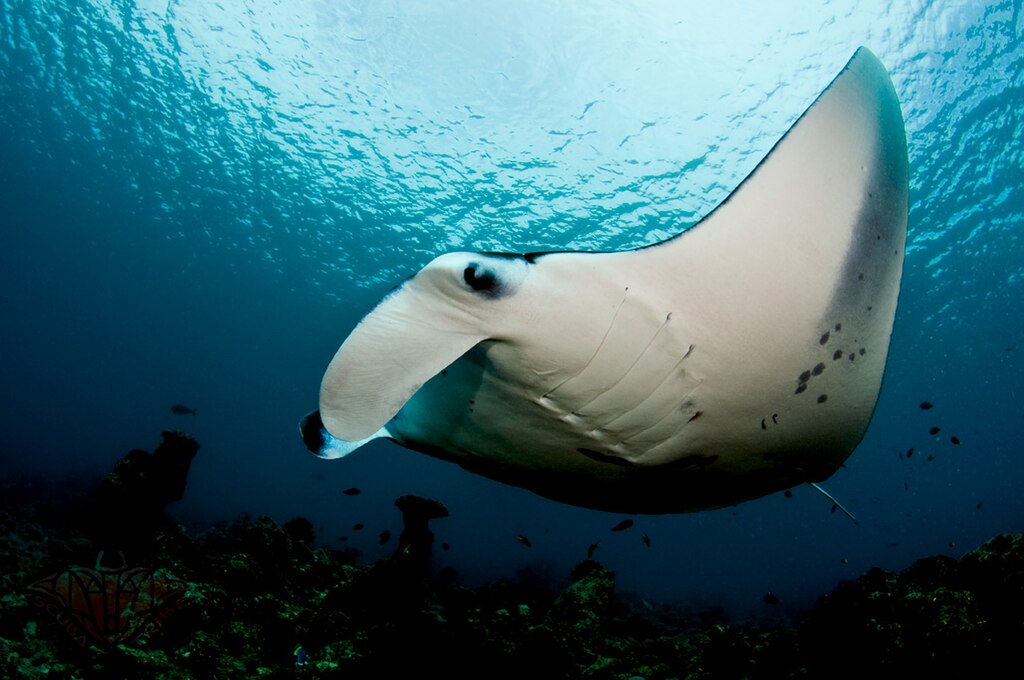
Manta alfredi at Dharavandhoo, Maldives
Manta birostris at Hin Daeng, Thailand
Taxonomy and etymology
| ||||||||||||||||||||||||||||||||||||||||||||||||||||||||||||||||||||||||||||||||||||
| Phylogeny of stingrays (Myliobatiformes)[3] |
Manta rays are members of the order Myliobatiformes which consists of stingrays and their relatives.[3] The genus Manta is part of the eagle ray family Myliobatidae, where it is grouped in the subfamily Mobulinae along with the Mobula devil rays.[6] In 2017, an analysis of DNA—and, to a lesser degree, morphology—found that Mobula was paraphyletic with respect to the manta rays, and they recommended treating Manta as a junior synonym of Mobula.[7]
Mantas evolved from bottom-dwelling stingrays, eventually developing more wing-like pectoral fins.[8] M. birostris still has a vestigial remnant of a sting barb in the form of a caudal spine.[9] The mouths of most rays lie on the underside of the head, while in mantas they are right at the front.[10] Manta rays and devil rays are the only ray species that have evolved into filter feeders.[3]
Species
The scientific naming of mantas has had a convoluted history, during which several names were used for both the genus (Ceratoptera, Brachioptilon Daemomanta and Diabolicthys) and species (such as vampyrus, americana, johnii and hamiltoni). All were eventually treated as synonyms of the single species Manta birostris.[11][12][13] The genus name Manta was first published in 1829 by Dr Edward Nathaniel Bancroft of Jamaica.[11] The specific name birostris is ascribed to Johann Julius Walbaum (1792) by some authorities and to Johann August Donndorff (1798) by others.[13] The name alfredi was first used by Australian zoologist Gerard Krefft, who named the manta after Prince Alfred.[12][14]
Manta alfredi with mouth closed, cephalic fins rolled and ventral surface showing distinctive markings
A third possible species, preliminarily called Manta sp. cf. birostris, reaches at least 6 m (20 ft) in width, and inhabits the tropical west Atlantic, including the Caribbean. It and M. birostris occur in sympatry.[9]
Fossil record
While some small teeth have been found, few fossilized skeletons of manta rays have been discovered. Their cartilaginous skeletons do not preserve well as they lack the calcification of the bony fish. Only three sedimentary beds bearing manta ray fossils are known, one from the Oligocene in South Carolina and two from the Miocene and Pliocene in North Carolina.[1] Remains of an extinct species have been found in the Chandler Bridge Formation of South Carolina. These were originally described as Manta fragilis but were later reclassified as Paramobula fragilis.[19]Biology
Appearance and anatomy
Side view of M. birostris
M.alfredi with cephalic fins rolled up (Yap, Micronesia)
Mantas move through the water by the wing-like movements of their pectoral fins, which drive water backwards. Their large mouths are rectangular, and face forward as opposed to other ray and skate species with downward-facing mouths. The spiracles typical of rays are vestigial, and mantas must swim continuously to keep oxygenated water passing over their gills.[22]:2–3 The cephalic fins are usually spiralled, but flatten during foraging. The fish's gill arches have pallets of pinkish-brown spongy tissue that collect food particles.[12] Mantas track down prey using visual and olfactory senses.[23] They have one of the highest brain-to-body mass ratios[24] and the largest brain size of all fish.[25] Their brains have retia mirabilia which may serve to keep them warm.[26] M. alfredi has been shown to dive to depths of over 400 m,[27] while their relative Mobula tarapacana, which has a similar structure, dives to nearly 2000 m;[28] the retia mirabilia probably serve to prevent their brains from being chilled during such dives into colder subsurface waters.[29]
Lifecycle
Manta alfredi group in the Maldives
The fertilized eggs develop within the female's oviduct. At first they are enclosed in an egg case while the developing embryos absorb the yolk. After hatching, the pups remain in the oviduct and receive additional nutrition from milky secretions.[32] With no umbilical cord or placenta, the unborn pup relies on buccal pumping to obtain oxygen.[33] Brood size is usually one or occasionally two. The gestation period is thought to be twelve to thirteen months. When fully developed, the pup resembles a miniature adult and is expelled from the oviduct with no further parental care. In wild populations, an interval of two years between births may be normal, but a few individuals become pregnant in consecutive years, demonstrating an annual ovulatory cycle.[32] The Okinawa Churaumi Aquarium has had some success in breeding M. alfredi, with one female giving birth in three successive years. In one of these pregnancies, the gestation period was 372 days and at birth the pup had a width of 192 cm (76 in) and weight of 70 kg (150 lb).[34] In southern Africa M. birostris males mature at 4 m (13 ft) while females reach maturity slightly over that.[35]:57 In Indonesia, M. birostris males appear to mature at 3.75 m (12 ft) while female mature at around 4 m (13 ft).[36] In southern Africa M. alfredi matures at widths of 3 m (10 ft) for males and 3.9 m (13 ft) for females.[35]:42 In the Maldives, male M. alfredi mature at a width of 2.5 m (8 ft 2 in) while females mature at 3 m (9.8 ft).[16] In Hawaii, M. alfredi mature at a width of 2.8 m (9 ft 2 in) for males and 3.4 m (11 ft) for females.[37] Female mantas appear to mature at 8–10 years.[16][17] Manta rays may live for as long as 50 years.[21]
Behavior and ecology
Manta alfredi foraging with mouth opened wide and cephalic fins spread
Manta alfredi at a coral reef cleaning station with fish picking off parasites
Mantas visit cleaning stations on coral reefs for the removal of external parasites. The ray adopts a near-stationary position close to the coral surface for several minutes while the cleaner fish consume the attached organisms. Such visits most frequently occur when the tide is high.[38] In Hawaii, wrasses provide the cleaning; some species feed around the manta's mouth and gill slits while others address the rest of the body surface.[22] In Mozambique, sergeant major fish clean the mouth while butterflyfishes concentrate on bite wounds.[35]:160 M. alfredi visits cleaning stations more often than M. birostris.[35]:233 Individual mantas may revisit the same cleaning station or feeding area repeatedly[39] and appear to have cognitive maps of their environment.[23]
Distribution and habitat
Mantas are found in tropical and subtropical waters in all the world's major oceans and also venture into temperate seas. The furthest from the equator they have been recorded is North Carolina in the United States (31ºN) to the north, and the North Island of New Zealand (36ºS) to the south. They prefer water temperatures above 68 °F (20 °C)[20] and M. alfredi is predominantly found in tropical areas.[9] Both species are pelagic. M. birostris lives mostly in the open ocean, travelling with the currents and migrating to areas where upwellings of nutrient-rich water increase prey concentrations.[40]Fish that have been fitted with radio transmitters have travelled as far as 1,000 km (620 mi) from where they were caught and descended to depths of at least 1,000 m (3,300 ft).[41] M. alfredi is a more resident and coastal species. Seasonal migrations do occur, but they are shorter than those of M. birostris.[16] Mantas are common around coasts from spring to fall, but travel further offshore during the winter. They keep close to the surface and in shallow water in daytime, while at night they swim at greater depths.[20]
Conservation issues
Threats
Frontal picture of M. birostris
Both commercial and artisanal fisheries have targeted mantas for their meat and products. They are typically caught with nets, trawls and harpoons.[17] Mantas were once captured by fisheries in California and Australia for their liver oil and skin; the latter were used as abrasives.[12] Their flesh is edible and is consumed in some countries, but is unattractive compared to other fish.[42] Demand for their gill rakers, the cartilaginous structures protecting the gills, has recently entered Chinese medicine.[43] To fill the growing demand in Asia for gill rakers, targeted fisheries have developed in Philippines, Indonesia, Mozambique, Madagascar, India, Pakistan, Sri Lanka, Brazil and Tanzania.[42] Each year, thousands of manta rays, primarily M. birostris, are caught and killed purely for their gill rakers. A fisheries study in Sri Lanka and India estimated that over 1000 were being sold in the country's fish markets each year.[44] By comparison, M. birostris populations at most of the key aggregation sites around the world are estimated to have significantly fewer than 1000 individuals.[45] Targeted fisheries for manta rays in the Gulf of California, the west coast of Mexico, India, Sri Lanka, Indonesia, and the Philippines have reduced populations in these areas dramatically.[17]
Manta rays are subject to other anthropogenic threats. Because mantas must swim constantly to flush oxygen-rich water over their gills, they are vulnerable to entanglement and subsequent suffocation. Mantas cannot swim backwards and, because of their protruding cephalic fins, are prone to entanglement in fishing lines, nets / ghost nets, and even loose mooring lines. When snared, mantas often attempt to free themselves by somersaulting, tangling themselves further. Loose, trailing line can wrap around and cut its way into its flesh, resulting in irreversible injury. Similarly, mantas become entangled in gill nets designed for smaller fish.[46] Some mantas are injured by collision with boats, especially in areas where they congregate and are easily observed. Other threats or factors that may affect manta numbers are climate change, tourism, pollution from oil spills, and the ingestion of microplastics.[17]
Status
Manta birostris at Hin Daeng, near Phi Phi Islands, Thailand
In the same year, M. alfredi was also classified as 'Vulnerable' with local populations of fewer than 1000 individuals and little or no interchange between subpopulations.[16] The Manta Trust is a UK-based charity dedicated to research and conservation efforts for manta rays. The organization's website is also an information resource for manta conservation and biology.[49]
Besides these international initiatives, some countries are taking their own actions. New Zealand has banned the taking of manta rays since the introduction of the Wildlife Act in 1953. In June 1995, the Maldives banned the export of all ray species and their body parts, effectively putting a stop to manta fishing as there had not previously been a fishery for local consumption. The government reinforced this in 2009 with the introduction of two marine protected areas. In the Philippines, the taking of mantas was banned in 1998, but this was overturned in 1999 under pressure from local fishermen. Fish stocks were surveyed in 2002, and the ban was reintroduced. The taking or killing of mantas in Mexican waters was prohibited in 2007. This ban may not be strictly enforced, but laws are being more rigidly applied at Isla Holbox, an island off the Yucatán Peninsula, where manta rays are used to attract tourists.
In 2009, Hawaii became the first of the United States to introduce a ban on the killing or capturing of manta rays. Previously, there was no fishery for mantas in the state, but migratory fish that pass the islands are now protected. In 2010, Ecuador introduced a law prohibiting all fishing for manta and other rays, their retention as bycatch, and their sale.[17]
Relation to humans
Ceramic manta ray made by Moche people, 200 AD. Larco Museum Lima, Peru
Aquariums
Manta alfredi at Okinawa Churaumi Aquarium
The Atlantis resort on Paradise Island, Bahamas, hosted a manta named "Zeus" which was used as a research subject for three years until it was released in 2008.[55] The Okinawa Churaumi Aquarium also houses manta rays in the "Kuroshio Sea" tank, one of the largest aquarium tanks in the world. The first manta ray birth in captivity took place there in 2007. Although this pup did not survive, the aquarium has since seen the birth of three more manta rays in 2008, 2009, and 2010.[34]
Tourism
Manta alfredi and scuba diver
Manta alfredi during a dive at Hawaii
In 2014, Indonesia has brought in a fishing and export ban as it has realized that manta ray tourism is more economically beneficial than allowing the fish to be killed. A dead manta is worth $40 to $500 while manta ray tourism can bring in $1 million during the life of a single manta ray. Indonesia has 5.8 million square kilometers (2.2 million square miles) of ocean and this is now the world's largest sanctuary for manta rays.[59]
See also


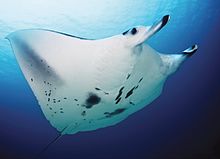
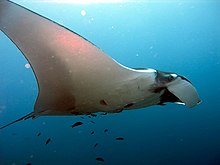
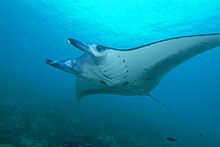

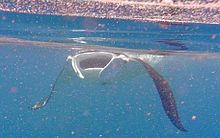

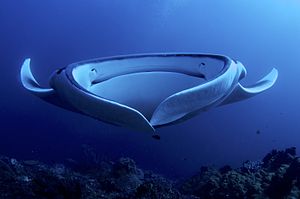

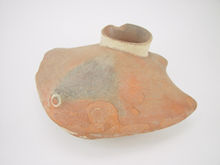


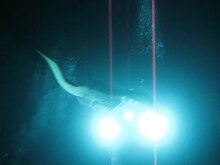


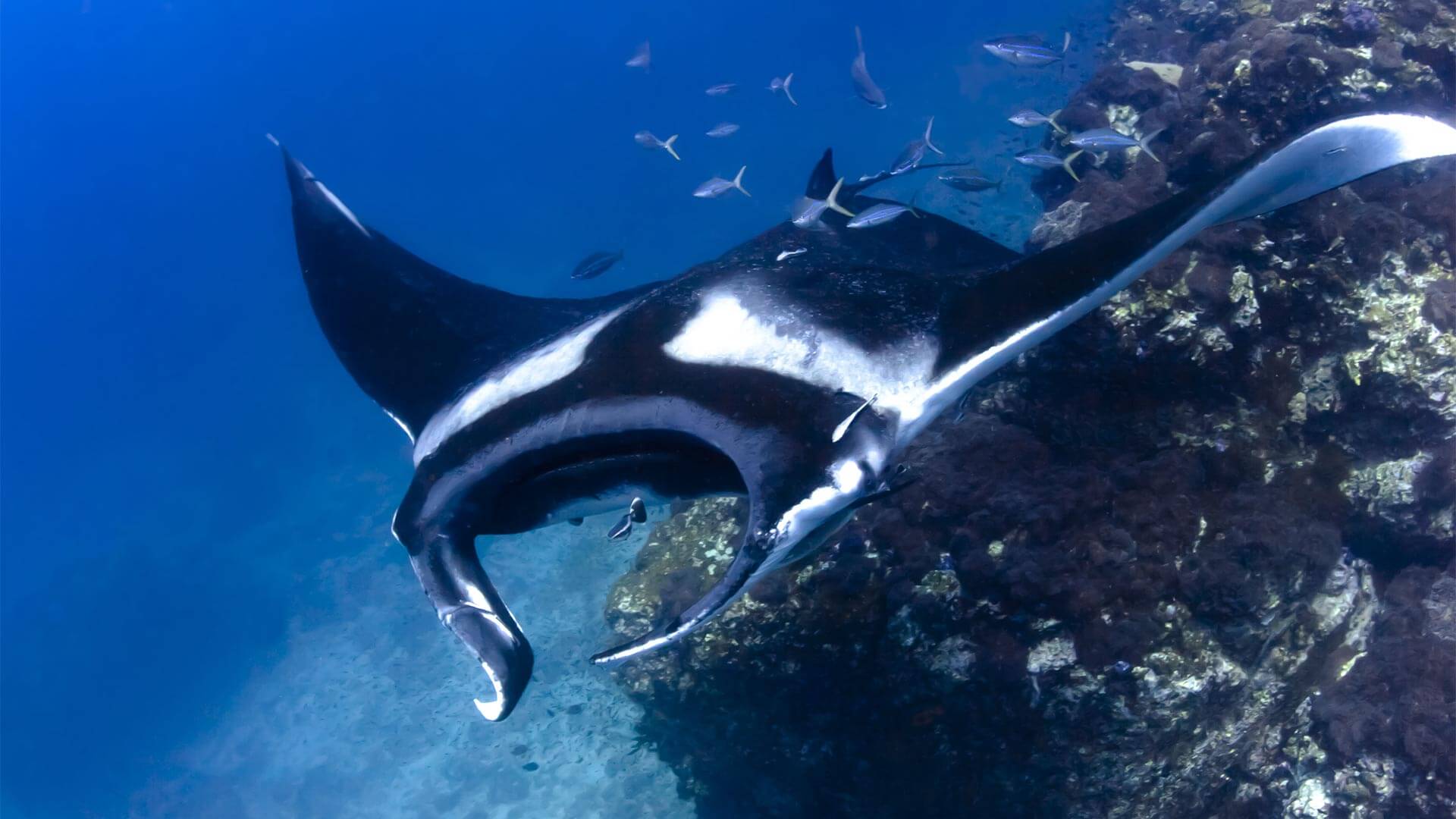
No comments:
Post a Comment
Note: Only a member of this blog may post a comment.